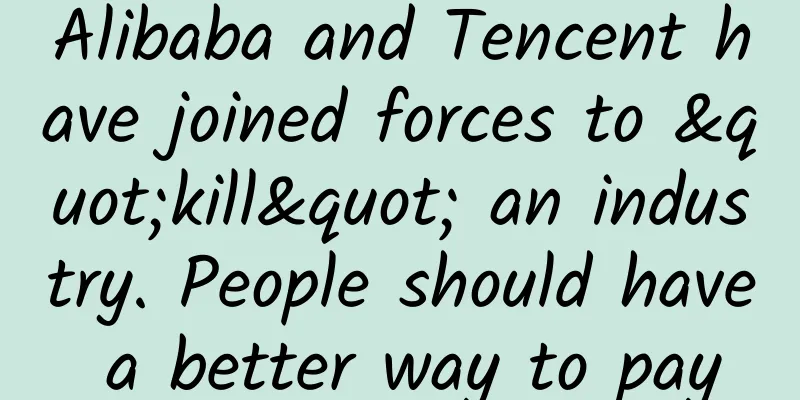Alibaba and Tencent have joined forces to "kill" an industry. People should have a better way to pay

|
This article is reprinted from the WeChat public account "悲了伤的白犀牛", written by 悲了伤的白犀牛. To reprint this article, please contact 悲了伤的白犀牛 public account. The two forces were fiercely "fighting" for the standard of mobile payment. There was no Alipay or WeChat Pay. Even at that time, Alipay was just an unknown little player, and WeChat had not even been born. Since Alipay's parent company Ant Financial "high-profile" disclosed its prospectus and capital gave a high valuation of up to 200 billion US dollars, it became the focus of the market for a while and attracted a lot of capital attention. It is worth noting that the competitive risks in Ant Group’s prospectus point out that some of these competitors may have a large amount of traffic and have established strong brand recognition, technical capabilities and financial strength. This competitor is generally considered to be Tencent's financial technology business. In terms of financial technology, Tencent's financial technology is indeed Ant Financial's primary competitor. From the payment war to the competition in all financial fields, Tencent has not shown any weakness. It is a recognized fact that Tencent's financial technology has grown into a new trump card that Tencent cannot hide. 01. Today, when people mention mobile payment, the first thing that comes to mind is definitely Alipay and WeChat. Many people even think that these two giants created this revolutionary model of mobile payment. In fact, 10 years ago, around 2008, domestic industry giants and the public were heatedly discussing how to implement mobile payment. To be specific, it should be said that two forces were "fighting" fiercely for the standard of mobile payment. There was no Alipay or WeChat Pay. Even at that time, Alipay was just an unknown small player, and WeChat had not even been born. The two forces at that time were China UnionPay, which was backed by a number of banking giants, and China Mobile, which was extremely wealthy and powerful at the time. In 2009, China UnionPay launched the 13.56MHz mobile payment standard commonly used in the international market. Shortly thereafter, China Mobile launched its independently developed 2.4GHz technical standard. The two sides engaged in a fierce battle over the standard. A year later, in order to win this battle, China Mobile invested 40 billion to acquire a stake in Pudong Development Bank, preparing to use Pudong Development Bank as a base to infiltrate UnionPay and carry out rebellion. For a period of time thereafter, the two sides were engaged in a brutal hand-to-hand fight. However, before they could decide the winner, the war between them had become meaningless because the city they were fighting for was suddenly swallowed up by an "outsider" in a very short period of time at lightning speed. This outsider was Alipay. 02. In February 2008, Alipay released its mobile e-commerce strategy and launched its mobile payment business. Three years later, in May 2011, Alipay obtained the first domestic "Payment Business License" (payment license) issued by the central bank. Two years later, by November 2013, Alipay's mobile payment users exceeded 100 million, making it the undisputed leader in the domestic mobile payment market. China UnionPay and China Mobile fought each other, but both ended up losing. Why did Alipay suddenly turn from an unknown little player into a big winner? The biggest key point is that it is unreasonable. Industry organizations and large state-owned enterprises such as China UnionPay and China Mobile pay attention to the big picture and style of doing things. They are used to setting rules before doing anything, and then everyone plays according to these rules. For example, financial transactions and telecommunications services have strict standards and specifications. If latecomers want to participate in the game, they must follow these standards and specifications. This is the so-called "no rules, no order". But Alipay ignored this. When the industry was choosing to stand with UnionPay or China Mobile, it did not choose to stand with them, but bypassed these two teams and went straight to the destination. It bypassed the so-called standard dispute through a simple QR code payment. More importantly, it did not try to lobby the industry to stand with it and make its own standards into industry regulations. Instead, it focused more on expanding merchants and users. Everyone knows what happened next. Alipay swallowed up the budding mobile payment market at that time. Along the way, Alipay encountered almost no decent competition and obstacles until it met WeChat. WeChat, with its huge user base and unique red envelope activities, snatched a large market from Alipay. The payment model adopted by WeChat is also a simple QR code payment. 03. If we compare the advantages and disadvantages of payment technologies of China UnionPay, China Mobile, Alipay and WeChat from a technical perspective, it can be said that China UnionPay and China Mobile both won overwhelmingly - the standard dominated by China UnionPay at the time was actually NFC, and the standard insisted by China Mobile was RFID. There is not much difference between the two in essence, and both are based on signal transmission between two objects with close geographical locations. Both of these are many times superior to QR code payment in terms of security, stability, technological advancement, and scalability. Of course, QR code payment also has its own advantages, such as simple usage process and low deployment and installation cost. The reality is that the simple and almost crude QR code payment defeated the advanced and secure NFC and RFID. From a commercial and market perspective, it was the "barbaric" Internet culture that defeated the rigid and stability-seeking state-owned enterprise culture. From a technical perspective, this can be said to be a complete case of "bad money driving out good money." If we assume that NFC technology had won out at the beginning, today NFC would have become a standard feature of our mobile phones. When paying at a convenience store, we no longer need to turn on the phone screen, unlock it, open Alipay, open the payment QR code, and hand it to the clerk to scan. We only need to confirm the amount and touch the phone to a device, or even complete the payment without touching it at all. Both efficiency and security will be greatly improved. Moreover, if NFC becomes mainstream, it will be used not only in electronic payment, but also in identity authentication, ticketing, data exchange, anti-counterfeiting, advertising and other fields. For example, in identity authentication, we can safely bind personal identity information to NFC, and we can quickly complete identity authentication at train stations and airports with our mobile phones. The above are just some basic functions. If NFC had won the war ten years ago, I believe that there will be a lot of rich applications based on NFC technology today. 04. It can be said that Alipay and WeChat have brought great convenience to people's lives today, but in fact, Alibaba and Tencent have also joined forces to "strangle" an industry that could be very large. People should have better payment methods, and even more, people should have a better lifestyle. |
<<: Can you get rockets by reading articles? Experience two major new features of WeChat
>>: A designer’s guide to artificial intelligence: basic concepts
Recommend
Xiaohongshu Promotion: After cleaning up KOLs, can we still “plant grass” well?
On May 10, Xiaohongshu announced the "Brand ...
What is the approximate price of customized mini programs purchased online? What factors are related to the price of customized mini programs in Zhuhai?
In order to ensure that the developed mini progra...
How to use new media to promote products
Before explaining new media operations, let’s fir...
Beautiful buttocks exercise Beibei Baidu cloud download
Beautiful buttocks exercise Beibei resource intro...
Top 10 Advertising Copywriters of 2018!
Recently I have seen many of my colleagues compil...
Don’t be afraid, talking about money with users is not that scary!
Does anyone have this feeling? Many operators are...
Absolutely useful information! Nine abnormal ways of operating Taobao and Tmall
Text/E-commerce consultant Lao Lu First summarize...
Why are mobile phone prices dropping so fast? There are three reasons
If you pay attention to the dynamics of the mobil...
Classic "Event Marketing" Cases You Must Know When Operating an App
Topic marketing and event marketing are unfathoma...
iOS 17 update, major features return!
Early this morning, Apple pushed the iOS 17 beta ...
Baidu promotion information flow video advertising display style - large picture video style
Style Overview Presentation location 1: Baidu APP...
Very interesting, how to view code as a crime scene
Measuring software complexity is a popular and co...
How much does it cost to customize a wedding banquet mini program in Nanyang?
According to industry insiders, mini programs wil...
Game live streaming platform: Huya Live Development Analysis
The author of this article analyzes the main func...
2020 Zero-cost Money-Making Strategy, Easily Earn 200+ Every Day
The online money-making project I shared today, a...









